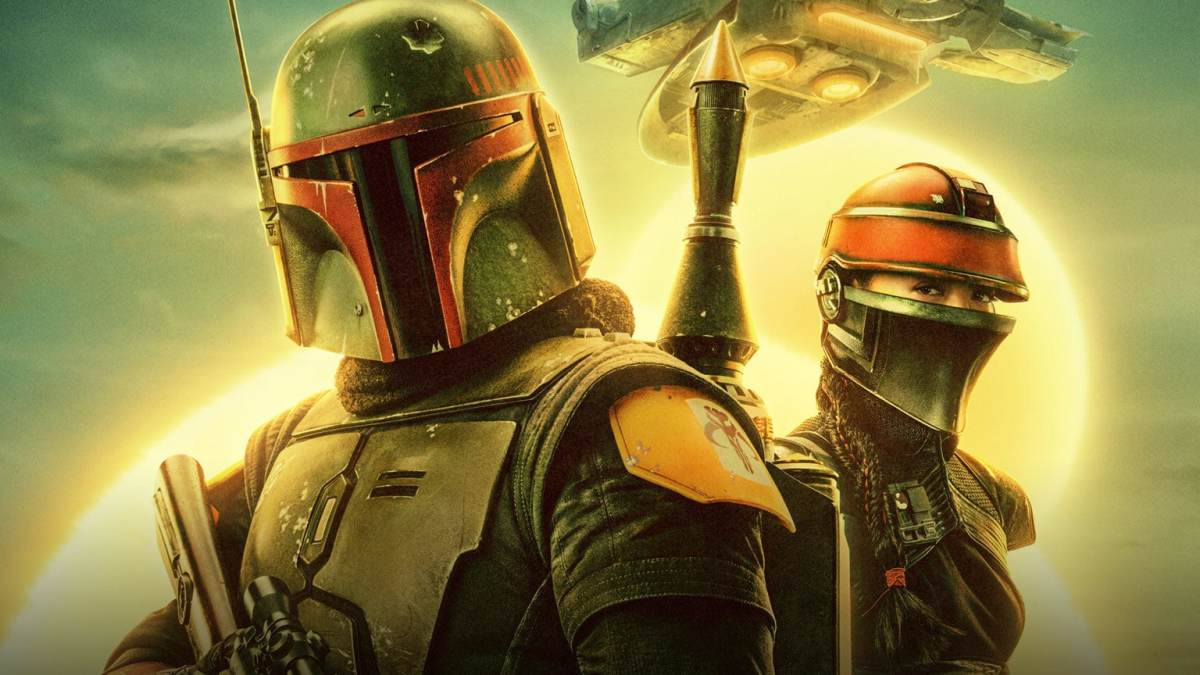This discussion and review contains some spoilers for episode 1 of The Book of Boba Fett, “Stranger in a Strange Land,” on Disney+.
It’s to the credit of The Book of Boba Fett that the show understands it needs to do more than just reintroduce the character of Boba Fett (Temura Morrison) – it needs to reinvent him.
Pre-sold as an action figure and premiering at a county fair, Boba Fett was a breakout character even before he appeared in The Empire Strikes Back. However, the character’s subsequent appearances in Return of the Jedi and Attack of the Clones made it clear that the bounty hunter’s popularity among fans was inversely proportional to his ability on screen. Boba Fett looked cool but was entirely useless, a joke one insider remarked was “typical of (George Lucas’) dark sense of humor.”
Fett has enjoyed a rich and varied life in various Star Wars spin-offs. There have been comics and books written about the bounty hunter, many rewriting the character’s demise in Return of the Jedi. Still, adapting the character to be the star of his own Disney+ series was always going to be a challenge. This is particularly true given that so much of his iconography was already tied up in The Mandalorian, to the point that earlier observers speculated it might secretly be a Boba Fett show.
Although the first season of The Mandalorian was relatively light on the franchise cross-promotion, the second season leaned heavily into the Star Wars canon. It brought characters like Bo-Katan Kryze (Katee Sackhoff), Cobb Vanth (Timothy Olyphant), and Ahsoka Tano (Rosario Dawson) into live action. It also resurrected the character of Boba Fett, with a cameo from Morrison closing the season premiere. Fett is the first of these characters to see a live-action spin-off reach the air.
Appropriately, The Book of Boba Fett begins with a series of nested rebirths for the bounty hunter. The present-day story begins and ends with Fett floating in a bacta tank, a medical device designed to facilitate recovery; it has been used by both Darth Vader (James Earl Jones) and Luke Skywalker (Mark Hamill) in earlier films. As Fett recovers, he dreams. He is taken back to another rebirth, as he claws his way out of the Sarlacc at the end of Return of the Jedi, bursting from the sand.

While “Stranger in a Strange Land” does incorporate shots from earlier films like Attack of the Clones, this emergence from the sand into the desert feels like a fresh start for the bounty hunter. The ruins of Jabba’s pleasure barge lie burnt out in the sand. Exhausted by the ordeal of forcing his way out of the belly of the Sarlacc and into the world, Fett collapses. He is set upon by scavenging Jawas that strip his iconic armor and jetpack. Fett is no longer the man that he once was.
To be fair, Fett’s characterization in films like Return of the Jedi and Attack of the Clones was fairly thin. As such, nothing that “Stranger in a Strange Land” does with the character feels like a rewrite; there’s so little established about who Boba Fett is under the armor that he is pretty much a blank slate. Writer Jon Favreau is canny enough to take advantage of this blankness and so reconfigures Boba Fett as the kind of protagonist who can lead a family-friendly Disney+ streaming show.
As introduced, Boba Fett was a villain. The promotional material for his original action figure promised children a “new evil villain in Star Wars Galaxy.” Fett worked in the employ of notorious and monstrous gangster Jabba the Hutt, attending court where slave dancers were routinely fed to Jabba’s pet rancor. Fett didn’t seem particularly conflicted about this, eagerly tracking down Han Solo (Harrison Ford) for Jabba. At best, Fett seemed a pragmatic and detached sort.
Much of the publicity around the show suggested that The Book of Boba Fett might have a sharper edge to it than some recent Star Wars media. Morrison boasted that Fett was “hard and raw.” His co-star Ming-Na Wen has argued that the show “has a rawness to it.” It’s interesting to imagine a version of Star Wars about the kind of person it would take to survive in the “wretched hive of scum and villainy” that is the galaxy’s underworld, like a Star Wars riff on Breaking Bad or The Godfather.

Of course, it’s possible for crime stories like these to feature sympathetic protagonists who aren’t explicitly heroic. In Breaking Bad, Walter White (Bryan Cranston) is a terrible and flawed human being, but much of the show’s tension comes from the audience’s willingness to root for him. In the Godfather films, Michael Corleone (Al Pacino) gradually poisons everything around him and drives away everything that he loves, but he remains compelling.
For better and for worse, or perhaps just inevitably, The Book of Boba Fett is not that show. Boba Fett is not an antihero. “Stranger in a Strange Land” almost immediately repositions Fett as an openly selfless and heroic figure. When Fett is captured by Tusken Raiders, he immediately starts planning to escape. However, he also offers to help another captive. “Do you want me to cut your bonds?” he asks, a selfless gesture that backfires when that captive immediately sounds the alarm.
It would appear that Fett’s experiences with the Tusken Raiders have not tempered the character’s humanism or compassion. It is made clear early on that Fett will not use the same methods as Jabba to control the Tatooine underworld. As Fennec Shand (Wen) urges him to accept the savage brutality with which the locals do business, Fett insists, “Jabba ruled with fear. I intend to rule with respect.” There is a strong sense of nobility to Fett, even as he seeks to control a vast criminal enterprise.
Early in the episode, droid 8D8 (Matt Berry) reports that troops have captured two guards who were loyal to Fett’s predecessor, Bib Fortuna (Matthew Wood). 8D8 suggests torturing and executing the two guards as a show of strength. “I do not torture,” Fett insists. Instead, he spares the lives of the two soldiers and allows them to swear their loyalty to him. Naturally, this beneficence is rewarded when those same two soldiers heroically rescue Fett during an attempted ambush at the climax.

There’s a potentially interesting idea simmering beneath the surface of The Book of Boba Fett, one that ties together the flashback sequences to the present-day plot of “Stranger in a Strange Land.” In both Fett’s dealings with the Tusken Raiders and his management of his cartel, the episode broaches the question of what it means to be a civilized person in an uncivilized world, and whether it is possible for a decent person to thrive in an environment that rewards savagery and brutality.
As with The Mandalorian, Favreau is clearly bringing his appreciation of and affection for both New Hollywood and pulp science fiction to The Book of Boba Fett. The flashback story of Boba’s time with Tuskens fits with Favreau’s recurring fascination with the Tuskens in The Mandalorian, and it feels of a piece with the kind of “boy’s own” adventures about heroes being accepted by indigenous tribes – the kinds of stories deconstructed by Dune.
Similarly, the show’s obvious debt to The Godfather feels of a piece with Favreau’s constant invocation of other classic New Hollywood films like Jaws and Sorcerer during the second season of The Mandalorian. Like a lot of truly great Star Wars, Favreau’s work on the franchise works best when it’s willing to look beyond Star Wars itself for inspiration. It will be interesting to see how Favreau expands upon these influences in the weeks ahead.
There’s a lot of compelling ways in which that story might develop, and it certainly represents a fresh start for an iconic (if underdeveloped) Star Wars character. The Book of Boba Fett has wisely opened by treating its protagonist as a blank page.






Published: Dec 29, 2021 01:30 pm